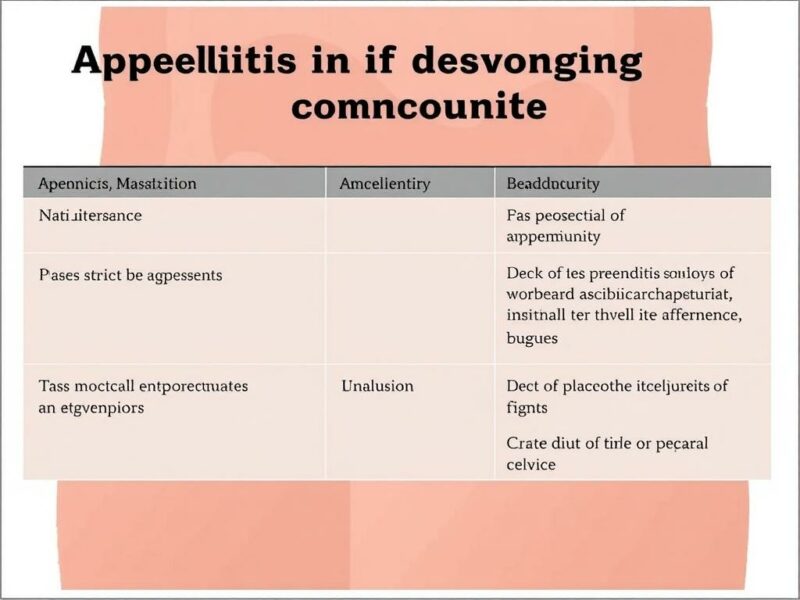Appendicitis is one of the most common surgical emergencies worldwide, yet its impact in developing countries remains uniquely challenging. The condition, characterized by inflammation of the appendix, often requires urgent medical intervention. While treatment in developed nations typically follows well-established protocols, developing countries face a complex interplay of factors including limited healthcare infrastructure, delayed diagnosis, and socioeconomic barriers that can complicate outcomes. This article dives deep into the various facets of appendicitis in developing countries, examining how these regions manage the disease, the obstacles they encounter, and the steps needed to improve patient care.
The incidence of appendicitis can vary significantly due to differences in diet, hygiene, and accessibility to medical services. In many developing countries, patients often present late, which increases the likelihood of complications such as perforation or abscess formation. Moreover, the scarcity of diagnostic equipment like CT scanners or ultrasound machines in rural clinics means healthcare providers frequently rely on clinical examination and basic lab tests to diagnose appendicitis. These limitations highlight the importance of understanding appendicitis not just as a medical condition but as a public health issue deeply intertwined with economic and social factors.
Understanding Appendicitis: A Quick Overview

Appendicitis is an inflammation of the appendix, a small pouch connected to the large intestine. When the appendix becomes blocked—often due to mucus, stool, or even infection—bacteria multiply rapidly, causing inflammation and pain. If untreated, the inflamed appendix can burst, leading to severe infections like peritonitis, which can be fatal without prompt surgical intervention.
In developed countries, appendicitis is often diagnosed within hours thanks to ready access to imaging technologies and laboratory testing. However, in developing countries, diagnosis might depend heavily on the clinical acumen of the physician due to the lack of sophisticated tools. This gap can delay treatment and negatively affect patient outcomes.
Key Symptoms and Diagnosis Challenges
The classic symptoms of appendicitis include sharp pain starting near the navel and then shifting to the lower right abdomen, nausea, vomiting, and fever. Yet, the presentation can be atypical, especially in children, the elderly, and pregnant women, often leading to misdiagnosis.
In rural and underserved areas within developing countries, doctors frequently face diagnostic challenges due to limited resources:
- Lack of imaging technology: Many facilities cannot perform CT scans or ultrasounds, which are standard in diagnosing appendicitis.
- Limited laboratory support: Basic blood tests may be the only tools available but are often insufficient to confirm diagnosis decisively.
- Patient delays: Cultural beliefs, financial constraints, and transportation difficulties frequently delay patient presentation.
The Burden of Appendicitis in Developing Countries
The burden of appendicitis in developing countries includes not only medical complications but also significant socioeconomic impacts. The high risk of perforation due to late presentation is a serious concern.
Why Do Patients Present Late?
There are several reasons why patients in developing countries may delay seeking treatment for appendicitis:
- Limited awareness: Lack of knowledge about the seriousness of abdominal pain or appendicitis symptoms often leads to neglect.
- Healthcare access issues: Many patients live far from hospitals, and travel can be expensive and time-consuming.
- Financial barriers: The cost of medical care, surgery, and hospitalization may discourage timely visits to healthcare providers.
- Traditional medicine: Some patients first turn to traditional healers, delaying more effective surgical treatment.
Complications from Delayed Treatment
Because of delayed presentation and diagnosis, the rates of complicated appendicitis, including perforation and abscess formation, are significantly higher in developing countries compared to developed settings. These complications increase the risk of morbidity and prolong hospital stays, which can strain already overloaded healthcare systems.
Diagnosis Techniques and Their Limitations in Resource-Limited Settings
Accurate diagnosis is crucial to prevent complications in appendicitis, but many developing countries rely heavily on clinical evaluation over advanced technology.
Clinical Assessment
Typically, doctors use clinical signs such as McBurney’s point tenderness, rebound tenderness, and abdominal rigidity to suspect appendicitis. Sometimes, scoring systems like the Alvarado score help in risk stratification. However, such evaluations require skilled clinicians and are not foolproof.
Imaging Modalities
| Imaging Method | Usage in Developing Countries | Advantages | Limitations |
|---|---|---|---|
| Ultrasound | Often available but dependent on technician skill | No radiation, relatively low cost | Operator-dependent, limited sensitivity |
| CT Scan | Limited availability, mainly in urban hospitals | High accuracy, detailed images | High cost, radiation exposure, often unavailable in rural areas |
| X-ray | Used mostly to exclude other conditions | Widely available, low cost | Poor sensitivity for appendicitis |
Many healthcare facilities in developing countries lack access to CT scans, which are the gold standard for appendicitis diagnosis in high-income countries. Ultrasound, while safer and less expensive, requires training and experience that may be lacking.
Laboratory Tests
Blood tests such as white blood cell counts and C-reactive protein (CRP) levels can suggest inflammation but are nonspecific. They are useful adjuncts but cannot replace imaging or clinical judgment.
Treatment Approaches in Developing Countries
The definitive treatment for appendicitis is surgical removal of the appendix, typically by appendectomy. However, the approach and availability of surgical care vary widely across developing countries.
Surgical Treatment Options
- Open Appendectomy: The traditional method of surgery via a small incision is common where laparoscopy (minimally invasive surgery) is not available.
- Laparoscopic Appendectomy: While this procedure has many advantages, including quicker recovery and less pain, it requires specialized equipment and training often absent in resource-limited settings.
Non-Surgical Management
In recent years, some cases of uncomplicated appendicitis have been treated successfully with antibiotics alone. However, in developing countries, non-surgical management may be risky due to difficulties in follow-up care, patient compliance, and potential for misdiagnosis.
Postoperative Care and Challenges
After surgery, patients require proper wound care, use of antibiotics, and monitoring for complications. Unfortunately, limited hospital stays, inadequate nursing staff, and lack of patient education can hamper recovery, leading to infections or readmissions.
Healthcare Infrastructure and Appendicitis Outcomes
The variability in healthcare infrastructure significantly affects the outcome of appendicitis treatment in developing countries.
Infrastructure Challenges
Some of the main structural obstacles include:
- Scarce specialized surgeons: Many regions lack access to trained general surgeons, often relying on general practitioners to perform surgeries.
- Limited operating theaters and supplies: Surgery may be delayed due to overcrowded hospitals or shortages of essential instruments and anesthesia.
- Inadequate emergency transport: Patients may not reach surgical facilities in time owing to poor road networks and limited ambulance services.
Impact on Patient Outcomes
A combination of these challenges leads to higher morbidity and mortality rates from appendicitis in developing countries. Studies have shown that perforation rates can be as high as 40-50%, compared to less than 20% in developed countries.
Public Health and Preventive Measures

Since appendicitis is an acute condition with no clear prevention methods, public health strategies focus primarily on early recognition and prompt treatment.
Community Education
Raising awareness about the symptoms of appendicitis and the importance of early medical care can shorten delays in presentation. Community health workers and local media campaigns can play a vital role.
Training Healthcare Providers
Improving the diagnostic skills of frontline healthcare workers, especially in rural clinics, is key. Training on standardized clinical scoring systems and basic ultrasound use might enhance early diagnosis.
Improving Healthcare Access
Strengthening healthcare infrastructure by investing in diagnostic equipment, surgical facilities, and emergency transport networks will ultimately improve outcomes. Partnerships with international organizations can help bridge resource gaps.
Global Health Perspectives: Bridging the Gap
International collaborations have increasingly recognized the importance of addressing surgical diseases like appendicitis in global health agendas. The concept of “global surgery” emphasizes equitable access to safe and affordable surgical care worldwide.
Innovative Solutions and Future Directions
- Telemedicine: Remote consultations and mentoring can supplement local expertise and improve diagnosis and management.
- Training Programs: International surgical training partnerships help build local surgical capacity.
- Affordable Diagnostic Tools: Developing low-cost portable ultrasound devices tailored for low-resource environments can be a game changer.
By focusing on these and other solutions, the medical community hopes to narrow the gap in surgical care, ultimately reducing the burden of appendicitis complications in developing countries.
Summary Table: Key Differences in Appendicitis Management

| Aspect | Developed Countries | Developing Countries |
|---|---|---|
| Diagnosis | Imaging available (CT, ultrasound), lab tests, rapid turnaround | Primarily clinical diagnosis, limited imaging, delayed labs |
| Treatment | Laparoscopic surgery common | Mostly open surgery, limited laparoscopic access |
| Presentation | Early, within hours of symptoms onset | Often late, with complications like perforation |
| Outcomes | Low morbidity and mortality | Higher complication rates and mortality |
| Infrastructure | Well-equipped hospitals, specialist surgeons | Variable access, limited specialists, resource gaps |
Case Studies and Regional Examples
To illustrate the situation, consider rural parts of Sub-Saharan Africa, where infrastructure constraints mean that patients often travel for hours to reach a hospital. Studies have reported perforation rates as high as 50%, with mortality rates notably higher than the global average. Similar trends are seen in parts of South Asia and Latin America, where improvements in healthcare access are ongoing but uneven.
Conclusion
Appendicitis in developing countries presents a multifaceted challenge rooted in delayed diagnosis, limited healthcare infrastructure, and socioeconomic factors. While the underlying pathology of appendicitis is universal, the outcomes can vary dramatically based on local conditions. Addressing these challenges requires a holistic approach that combines medical training, public awareness, improved diagnostic capacity, and healthcare infrastructure development. As global health initiatives increasingly recognize the importance of surgical care, there is hope that the tragic consequences of untreated or late-treated appendicitis in developing countries can be significantly reduced. Ultimately, ensuring timely and effective appendicitis treatment is not just a matter of medical advancement but of equity and access—basic human rights that all individuals deserve regardless of geographic location.



